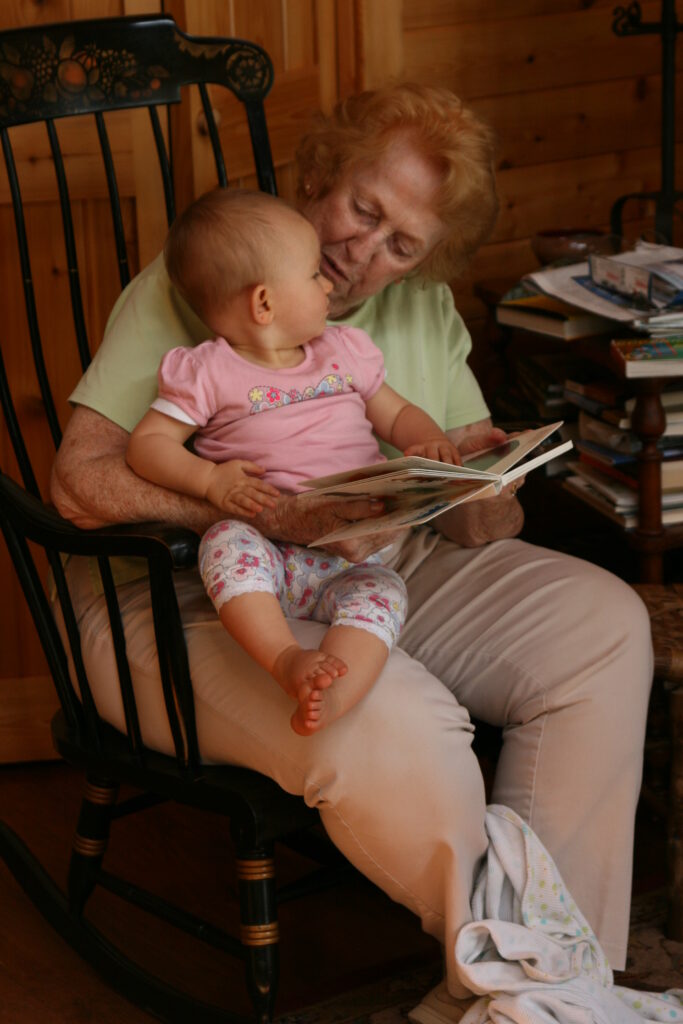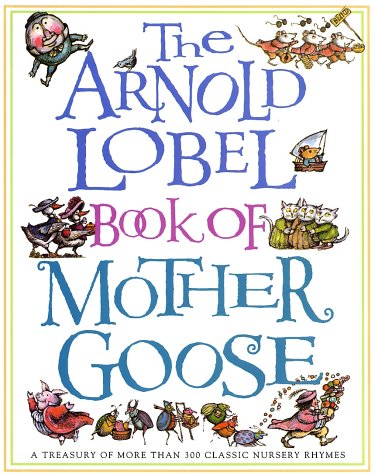Editor’s Note: It’s a new month–meaning a new chapter in our Honey for a Child’s Heart Read-along. Or actually, two chapters: #5: “Poetry” and #22: “Poetry Is for Pleasure.” What better way to introduce a child to the delights of rhyme and rhythm than reading aloud from a beautifully-illustrated collection of Mother Goose rhymes? Betsy and Janie talked about their best-beloved editions in an earlier post, and here Gladys Hunt shares some of her favorites.
Choosing Mother Goose
Originally published on the Tumblon website July 12, 2009
Every child should have an early friendship with Mother Goose! Those who know agree that nothing boosts language development better than the catchy rhymes of Mother Goose. Not only are they part of our culture and literary heritage, but reading, saying, singing these rhythms stimulates a child’s imagination. By early friendship, I mean right away—from birth. These nonsensical and fun rhymes have been in print for more than two hundred years and there are many editions to choose from.

Ralph Caldecott was among the first to illustrate “Hey Diddle Diddle” and “Bye Baby Bunting” with his own caricatures from English country life, and hundreds since have adapted these rhymes to their own artistic style. Some are sweet (like Kate Greenaway’s work) and others have a more rambunctious look with outlandish characters. Some are board books featuring a single rhyme and others are almost scholarly tomes (Peter and Iona Opie’s works.) Robert Sabuda has a pop-up book called The Moveable Mother Goose. If you look at the array of Mother Goose books on the market, you will notice that this Mother provides fodder for creativity. Mother Goose has been chanted, read, sung and re-read by millions of children.
Since there are so many editions on the market, how does a parent choose? By all means look at Iona Opie’s My Very First Mother Goose and its companion Here Comes Mother Goose, illustrated by Rosemary Wells. Some of the characters are human, but most are bunnies and mice or cats. The book is bright, bold and user-friendly with such creative illustrations that a child gets a second reading from the pictures. The pussycat who boasted of having “frightened a little mouse under the chair” looks pretty scared in Well’s drawing, suggesting maybe that cat wasn’t as brave as claimed. Most of the rhymes are short and lack all the verses, but it’s a good place to begin.
In his introduction to Mary Engelbreit’s Mother Goose, Leonard Marcus writes that “It is one of the happy truths about Mother Goose that it is absolutely impossible to sound too foolish while saying them.” He laments that the first rhymes most children learn come from television ads and holds out that it is refreshing to have an irresistible rhyme that has nothing to sell. Engelbreit’s book contains over one hundred rhymes and these are illustrated in her cheery greeting card style.

You will want also to consider Tomie dePaola’s Mother Goose which contains over 200 rhymes. dePaola’s art is charming and has a lot “to notice.” I like its unusual stanzas about Mother Goose herself, as well as a series of bedtime rhymes.
You will probably need more than one Mother Goose. As a child grows more literate and sophisticated in taste, you may want to have a copy like The Arnold Lobel Book of Mother Goose that has over 300 rhymes with all the extra verses of each story, lots of variety, limericks and ballads and whatever.
So how do you choose? Remember for little children that durability is important, a book that is the right size and not too overwhelming. It should contain the simpler verses that are easy to learn. Compare the illustrations in several collections to discover what your children might like best. And you will eventually want a more comprehensive collection that will find its place for years to come on the family library shelf for reference, for reading at parties, and whatever. It’s part of our heritage.
More on Mother Goose
Addendum to the Tumblon site on July 20, 2009

Speaking of Mother Goose –which I did in a previous post–here’s something you may want to check on. It’s a cloth-stuffed happy looking Mother Goose that stands on its own, about 12 inches long and almost that high. She wears sewn-on glasses and a bonnet with a friendly air. Her six wings are small pockets that each hold a small red book with a nursery rhyme that little fingers can remove and replace. Her back has a zipper that opens to reveal small-stuffed characters mentioned in the book rhymes: Jack and Jill, a clock and a mouse, Miss Muffet and a spider, Jack and his candlestick, etc. Our nine-month old granddaughter takes the books out of the wing pockets and pretends to be reading them and then pulls out the characters. It is a high quality piece, very attractive. And one of the best things about it is that the pieces can be replaced free if lost.
Check on it yourself online: pocketsoflearning.com. I bought mine from an Orvis catalog. I think it is a winner! And so does Olivia.
© Gladys M. Hunt 2008-10, reissued in 2022 with minor adjustments with permission of the Executor of the Literary Estate of Gladys M. Hunt (4194 Hilton SE, Lowell, MI 49331). Used by permission. All rights reserved.
Also at Redeemed Reader:
Review: For older readers, Jon Scieszka’s The Real Dada Mother Goose: A Treasury of Complete Nonsense subjects six familiar rhymes to the a variety of literary and language forms.
We are participants in the Amazon LLC affiliate program; purchases you make through affiliate links like the one below may earn us a commission. Read more here.
Support our writers and help keep Redeemed Reader ad-free by joining the Redeemed Reader Fellowship.
Stay Up to Date!
Get the information you need to make wise choices about books for your children and teens.
Our weekly newsletter includes our latest reviews, related links from around the web, a featured book list, book trivia, and more. We never sell your information. You may unsubscribe at any time.
We'd love to hear from you!
Our comments are now limited to our members (both Silver and Golden Key). Members, you just need to log in with your normal log-in credentials!
Not a member yet? You can join the Silver Key ($2.99/month) for a free 2-week trial. Cancel at any time. Find out more about membership here.

